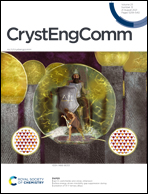Mechanisms of the surface reaction and crystal growth of cerium oxide by supercritical hydrothermal treatment with carboxylic acids†
Abstract
This study revealed the mechanisms of the surface reaction and crystal growth of cerium oxide (CeO2) by supercritical hydrothermal treatment with carboxylic acids. CeO2 particles with an average size of 16 nm were hydrothermally treated with decanoic acid in the temperature range of 300–400 °C. The average particle size became over 20 nm with decanoic acid whereas the particle size hardly changed without decanoic acid. Additionally, the octahedral shape of CeO2 changed to an ellipsoid shape after the treatment. Decanoic acid drastically increases the dissolved amount of cerium ions through formation of cerium(III) decanoate. Furthermore, the presence of water promotes reprecipitation of the cerium decanoate to CeO2 where cerium(III) decanoate acts as an intermediate of the dissolution and reprecipitation process. Appropriate amounts of decanoic acid and water accelerate this dissolution–reprecipitation cycle, which promotes particle growth. The higher temperature promotes particle growth because of the increase of the kinetics of complex formation and reprecipitation.

- This article is part of the themed collection: Nanomaterials


 Please wait while we load your content...
Please wait while we load your content...